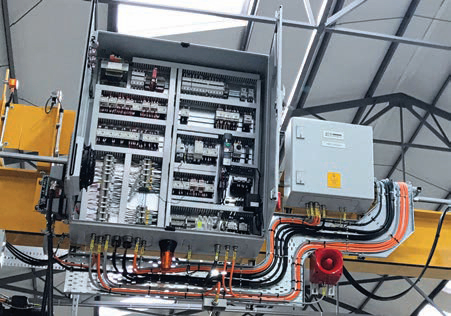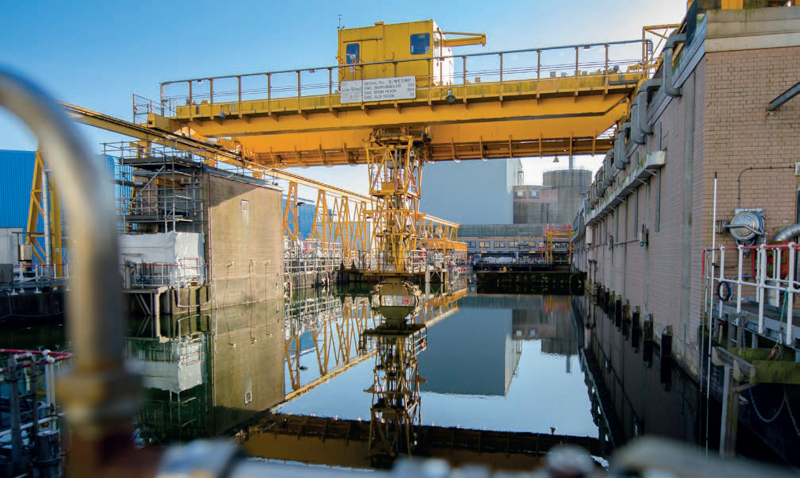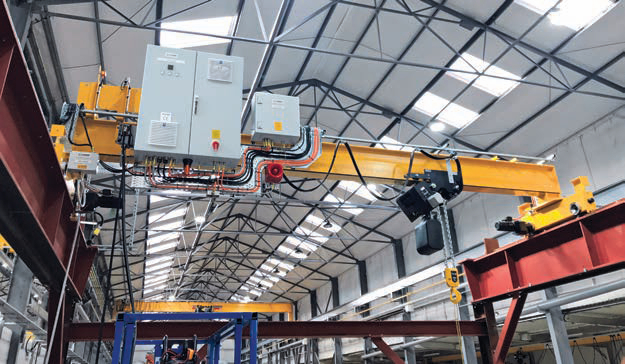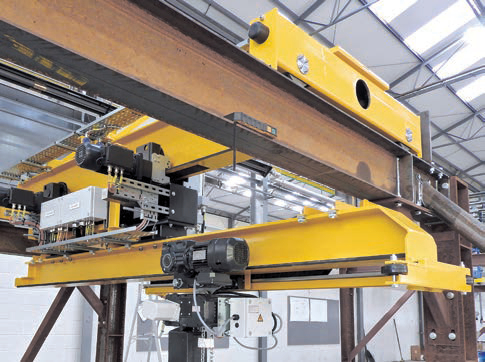Decommissioning milestone
12 January 2022The decommissioning of the UK’s nuclear power estate continues, with numerous complex handling challenges that need to be performed safely, reliably and accurately.
The Pile Fuel Storage Ponds (PFSP) at Sellafield are among the most challenging nuclear decommissioning projects in Europe. Following the completion of a key stage in the removal of larger solid wastes from the ponds, a new dewatering and descaling project can now begin, thanks to the team at SCX Special Projects.
The project requires two handling systems to reach hard-to-access parts of the PFSP’s structure, and to avoid potential collisions with existing lifting equipment.
Procured for Sellafield via Cumbria Nuclear Solutions (CNSL), SCX engineered two single girder cranes, each tailored to the ponds’ existing infrastructure and the task of enabling the next phase of decommissioning at Sellafield’s PFSP facility. A 2-ton MOTS (Modified Off The Shelf) crane with a bespoke extending, cantilevered bridge reaches into the numerous recesses along the pond’s wall. And a 4-ton COTS+ (Commercial Off- The-Shelf) crane equipped with collision avoidance technology shares the same rails as the existing 12-ton pond crane.
Speaking about the background to the project Stuart Robson, technical sales engineer, SCX, said Sellafield established the Decommissioning Delivery Partnership (DDP) in 2016 as a framework to deliver its substantial decommissioning and land remediation challenge. Originally planned to run for five years, in 2021 the DDP was extended by a further five years to 2026.
“The DDP is split into three Lots – Lots 2 and 3 focus on Magnox waste and swarf storage, while Lot 1 brings together two Pile Fuel facilities along with general site remediation and associated decommissioning work,” he said.
“Lot 1 contains three consortia – one of which is Cumbria Nuclear Solutions Limited (CNSL), a collaboration of six specialist nuclear businesses. One of the primary facilities in Lot 1 is called the Pile Fuel Storage Pond (PFSP) – this is among the most challenging nuclear decommissioning projects in Europe. PFSP had recently been emptied of larger solid wastes, completing an important phase in its decommissioning journey. Now the challenge is to descale and dewater the ponds. Led by consortium member Westinghouse, CNSL went to market in late 2018 with a requirement for “PFSP Enhanced Mechanical Handling” – in essence, two enhanced and modified cranes to help carry out the required lifting and handling associated with the next phase in the project. SCX was awarded the contract to design and supply the cranes in May 2019.”
Robson said the project progressed smoothly, and the modified cranes were designed, engineered, and assembled at SCX’s facilities in Sheffield during 2020 – at a time when Covid had already impacted many business activities. They passed Factory Acceptance Tests in late 2020 and were delivered to site and commissioned in summer 2021.
The requirements for the two cranes differed in complexity: the smaller 2-ton SWL crane needed an extending, cantilevered bridge to reach into the various recesses of the PFSP, which meant significant mechanical and electrical upgrades to a standard COTS crane.
The second 4-ton crane needed an anti-collision system, as it shares rails with an existing 12-ton crane, however mechanically it remains a relatively standard overhead travelling crane.
“Sellafield has its own exacting standards for electrical wiring and labelling, so all electrical upgrades were engineered and commissioned to meet those,” he adds.
“SCX has teams of mechanical, electrical and TÜV-certified safety design engineers that work together to create a solution that: satisfies the client’s functionality and budget, ensures the safety of the people working with the system and is practical to build and install.
“SCX’s experience in modifying commercial-off-the-shelf cranes goes back decades, and many of our solutions for the demanding nuclear sector have been designed and built this way. Using COTS equipment as the basis of a nuclear handling solution makes sense, because that equipment is already proven in industry. There’s no sense in reinventing the wheel and going bespoke – we always consider what we can do with existing, readily available and proven equipment first. If it’s not possible to deliver a fit-for-purpose system using the COTS/MOTS route, that’s when we explore the bespoke route.
A spokesman for CNSL said: “The project ran smoothly thanks to the good working relationships and collaboration between all parties. The design and manufacture was undertaken professionally by SCX, and when minor issues arose – to be expected in the development of bespoke handling solutions – they were resolved quickly and to our satisfaction.
“The challenge of Covid was unavoidable, however it was accommodated well, and solutions to any problems or delays were found in a timely manner.”
When asked about future developments in the nuclear sector, Robson explains: “The UK’s nuclear estate is ageing and the decommissioning effort will continue for many decades to come. The various sites and reactor types have their own unique challenges – with Sellafield being particularly special as a national centre for fuel reprocessing and conducting important experimental programmes. Dounreay is similar in many ways to Sellafield, while also sharing much in common with the Magnox estate, which is now on an accelerated path to full decommissioning. Throughout all these there will be a requirement for reliable, accurate and safe lifting and handling.”
New reactors are already being built (Hinkley Point C and Sizewell C is likely), innovative reactor designs such as SMRs and AMRs are getting close to launch, and fusion energy is gathering momentum as breakthroughs continue to be made. Across all of these, as with decommissioning, lifting and handling will play a key part in the build and operation of this new generation of nuclear power.
SCX is committed to proving safe, reliable handling solutions to the nuclear sector. Traditionally for SCX, that has almost exclusively been within the UK market, but increasingly we are looking to take our nuclear handling experience overseas.
The UK, because of its nuclear heritage, is seen as an extremely knowledgeable and capable market for nuclear handling. Other countries are already calling on that expertise to tackle their own nuclear challenges… Japan, Eastern Europe and Canada spring to mind… and lifting and handling will play a key part in solving those challenges too.



